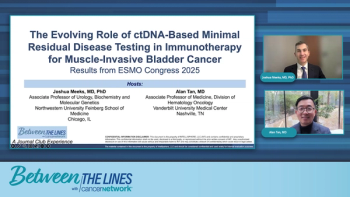
Practical Tips for Managing Nail and Skin Changes While Receiving Talquetamab
Panelists discuss how specific talquetamab-related adverse effects such as skin peeling, nail changes, and rashes can be effectively managed through targeted interventions, including topical treatments, protective measures, and preventive strategies tailored to the drug's unique toxicity profile.
Episodes in this series

Talquetamab-related skin toxicities result from GPRC5D expression in heavily keratinized tissues, particularly affecting palms and soles with characteristic peeling and sloughing. Management strategies focus on aggressive moisturization using emollients such as CeraVe, ammonium lactate 12% cream (AmLactin), and occlusive agents such as Aquaphor applied under cotton gloves overnight. Additional recommendations include topical steroids for inflammation and avoiding hot water exposure that can worsen skin toxicities.
Nail toxicities reflect GPRC5D expression in nail beds, leading to nail fragility, separation, and potential nail loss. Prevention strategies include nail hardeners, vitamin E cuticle oil, and newer products such as Polybalm (comprised of polyphenolic-rich herbal oils with organic waxes). Protective measures involve avoiding trauma through proper footwear, activity modifications, and using finger cots or bandages when nails begin separating to prevent catching them on clothing or hair.
Hygiene maintenance becomes critical during nail and skin toxicities to prevent secondary infections in immunocompromised patients. Recommendations include keeping nails short and clean, wearing gloves during household tasks such as dishwashing, and maintaining good handwashing practices. The comprehensive approach addresses both the active management of existing toxicities and the prevention of complications, recognizing that these effects are generally temporary and resolve over time with continued treatment.
Newsletter
Stay up to date on recent advances in the multidisciplinary approach to cancer.




















































































